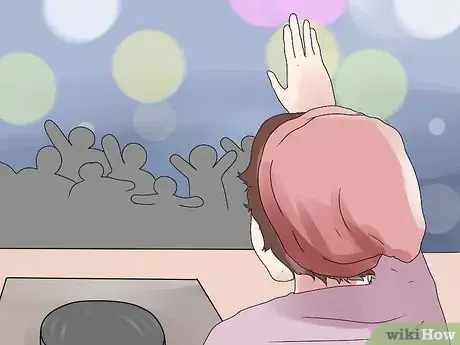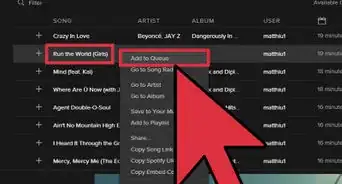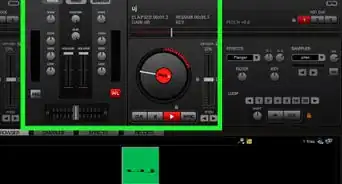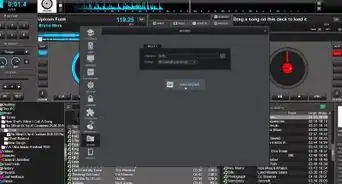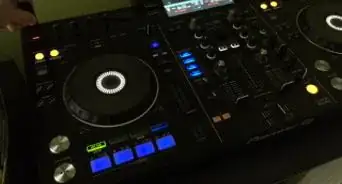X
wikiHow is a “wiki,” similar to Wikipedia, which means that many of our articles are co-written by multiple authors. To create this article, volunteer authors worked to edit and improve it over time.
This article has been viewed 70,500 times.
Learn more...
The true mark of a quality DJ is their ability to satisfy the crowd and keep people engaged. To be able to truly connect with one’s audience entails much more than playing records or doing fancy tricks. Playing the right songs and stringing them together in a cohesive fashion is the most important thing for a DJ and can be the difference between an event’s failure or success. Here’s a little guide on how to choose the right songs when DJ-ing an event.
Steps
-
1Set the tone. Remember that you are creating the mood and atmosphere of the event, so think about what is appropriate. To set the tone, you should take a few things into consideration.
- What type of event is it? The nature of the function you are playing should factor in hugely when deciding what music to play. You wouldn’t play the same songs in a rocker bar as you would at a wine and cheese party or a middle school dance, would you? Here are a couple rules of thumb for different events.
- When the focus of an event or a portion of an event should be on something other than the music, play soft, slower tempo music so as to not take attention away from whatever the true focus may be. For example, at an art opening, the focus should be on the art. During the dinner portion of a wedding, this time is usually used to get to know the people at one’s table. In these cases, slower, softer music without overbearing vocals should be used to keep the focus where it should be. Though your music should not be the focus at this time, your music is still an integral part of the event.
- When the focus of an event is dancing or partying, make sure to play more upbeat music for the people to dance or sing along to. In this case, your music is the main attraction and your job is to keep people moving.
- If you are playing at a lounge or somewhere where the music should inspire some movement, but also not overpower conversations, find a balance with music that gets people to groove, but is not so hard hitting that it will be a distraction. Depending on the crowd, melodic or soulful rhythms tend to work in this setting.
- What type of crowd is it? This is perhaps the one case where a certain amount of profiling is not such a bad thing. Many times, it is possible to get a loose grasp on the crowd’s musical taste by looking at their clothes, hairstyle, the way they walk, talk etc. This should not determine what you play the entire night, but instead be used as a testing basis, allowing you to feel out the crowd and better pinpoint their likes and dislikes.
- What type of event is it? The nature of the function you are playing should factor in hugely when deciding what music to play. You wouldn’t play the same songs in a rocker bar as you would at a wine and cheese party or a middle school dance, would you? Here are a couple rules of thumb for different events.
-
2Feel out the crowd. Now that you’ve found your starting point and have determined what genres might work best, it’s time to start honing in on what the crowd wants. The first few songs you play for a new audience are like an introduction, so it’s smart to play it a little bit safe until you get better acquainted. Depending on the crowd, top 40’s music is usually a safe bet, since most people hear these songs on a daily basis. Once you get a sense of which jams they respond to, you can decide what to play next to really satisfy them.Advertisement
-
3Build up the energy. Get them to crawl before they run. If you start off an event with too much excitement, there’s nowhere to go after that and everything else will seem a little disappointing. Also, people might not be ready for craziness right away. More often than not, folks are a little more reserved at the beginning of a party, so it’s important to use your music to stretch their social muscles and get them fully loosened up. As a DJ, you are in charge of bringing the party to its climax and sustaining it as long as possible. Make sure to build up the energy first so they have something to look forward to.
-
4Experiment and don’t be afraid to disappoint. Once you’ve managed to figure out what works with the crowd, you can start digging deeper into their musical tastes or even get them to fall in love with something they didn’t realize was missing from their lives. But, when you are attempting to expose people to something new, it’s important that you build a foundation of trust first. That way they’re more likely to accept something unfamiliar. If that has already been achieved, then it's time to really make your mark and separate yourself from the pack. Remember that you will not always please everyone, but at the same time you can’t be great unless you take chances.
- One thing you can do is playing a non-pop or “underground” song that has not received much exposure, but is a great song nonetheless. Nothing builds your reputation like having several people visit your booth asking you what song you’re playing.
- Remixes of popular songs are also a good way of making yourself stand out while playing it safe at the same time. With so many producers out now, you can find many quality remixes of songs at record shops or all over the internet.
- Creating remixes on the spot can get people to notice you by taking a popular beat or vocals from a song and switching them with the vocals or beat from another song with a matching tempo.
-
5Take it back. A lot of times, the best part of a party is when the DJ plays something nostalgic that allows people to revisit a time or recapture old feelings. Nothing takes you back like hearing an old song that you have fond memories of. However, it is important to make sure that the song you’re bringing back has not been played so much that it continues to be corny to this day. Unless, of course, that’s what the crowd wants to hear.
-
6Wind down. Just as it was your responsibility to build up the party, it’s your responsibility to cool it down. This is especially important when you are playing for a venue that wants you to help get everyone out at the end of the night. Make sure to play something down-tempo and non-danceable. At any club, a good exit song combined with the club’s “ugly lights” should be sufficient enough to get everyone to depart from the premises without any fighting or bickering.
Advertisement
Community Q&A
-
QuestionHow do I know which genre of music to play in pubs and clubs?
 Community AnswerFast, dance music is best for clubs so techno/house or electronica would be best. You can also remix some of your favorite songs to make them more suitable for a club or pub.
Community AnswerFast, dance music is best for clubs so techno/house or electronica would be best. You can also remix some of your favorite songs to make them more suitable for a club or pub. -
QuestionHow long should a song play ?
 Community AnswerOne individual song should be longer than one minute but shorter than 10 minutes. You'll need several songs for a set. A good length for an entire set would be approximately 3 hours, give or take depending on the gig.
Community AnswerOne individual song should be longer than one minute but shorter than 10 minutes. You'll need several songs for a set. A good length for an entire set would be approximately 3 hours, give or take depending on the gig.
Advertisement
About This Article
Advertisement





